Reduce Employee Turnover: 8 Effective Strategies for Retention
Last Updated Nov 4, 2025

Your team feels steady. Turnover rates have cooled. Things seem…fine.
But then someone quits. Again. And suddenly, you’re back to posting job ads, juggling interviews, covering gaps, and watching your team’s energy drain—one resignation at a time.
Now imagine a workplace where employees stay. They feel supported, connected, and motivated. Productivity climbs. Culture thrives. And HR gets to focus on growth instead of damage control.
That kind of stability doesn’t happen by accident. It starts with a clear retention strategy and having the right tools to put it into action.
Discover secrets to keeping your top talent and creating a workforce that’s built to last.
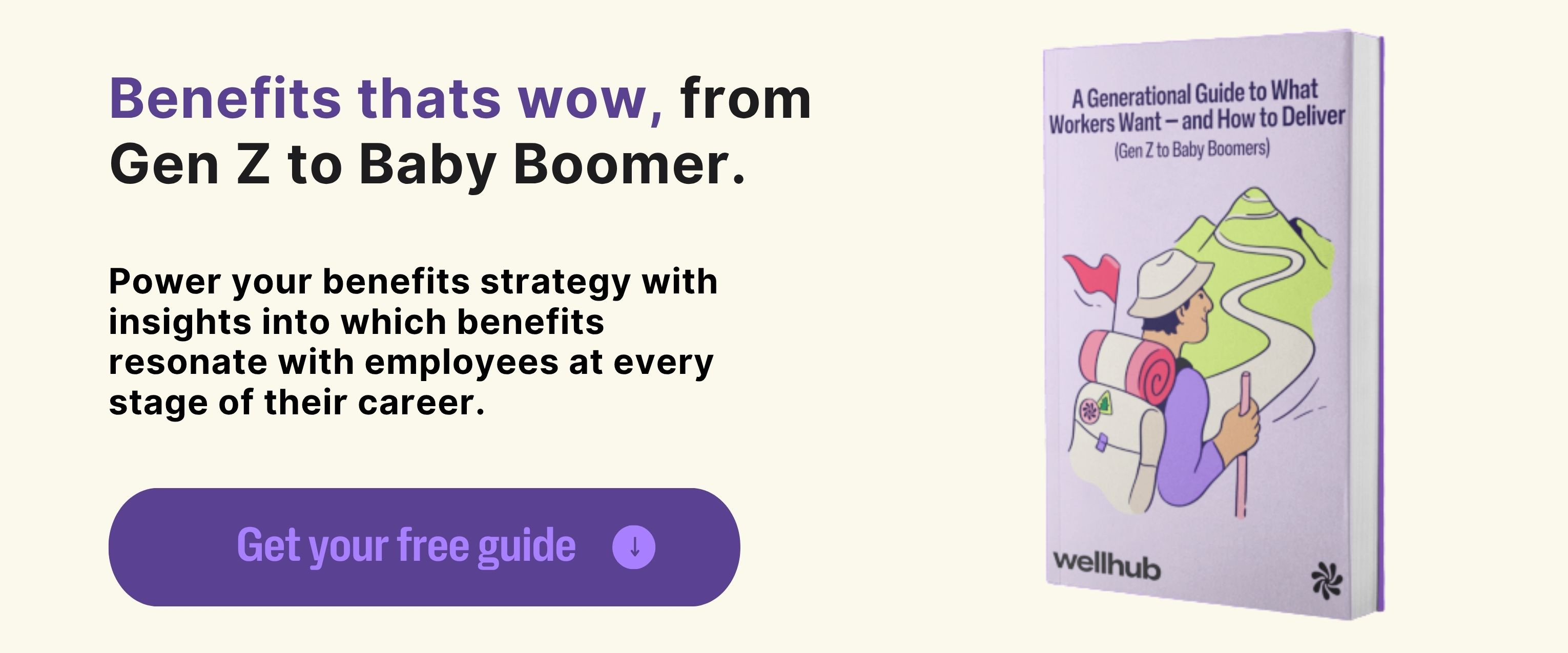
What You'll Learn
- What employee turnover is, the difference between voluntary and involuntary turnover, and how industry averages compare.
- Why high turnover harms productivity, morale, costs, and employer brand—while strong retention signals a healthy workplace.
- The true financial impact of turnover, including how replacement costs can reach up to twice an employee’s annual salary.
- Eight actionable strategies HR leaders can use to reduce turnover, from strengthening culture and career development to improving communication, benefits, and recruitment.
- How analyzing turnover data regularly helps identify root causes and ensures retention strategies are effective over time.
Employee Turnover, Explained
Employee turnover is the percentage of the total workforce that leaves during a given period, usually a year. It’s the opposite of employee retention, which refers to a company’s ability to keep its employees engaged and committed, thereby minimizing turnover and maximizing productivity.
High turnover can be disruptive and costly, while strong employee retention signals a healthy and sustainable workplace. What’s considered a “high” turnover rate depends on your industry. Across all industries, the average turnover ranges from 1.9% to 2.2%, according to a 2025 BambooHR report. Travel and hospitality sees the highest turnover rates, at an average of 2.8%, while government sees the lowest, with an average of 1.4%.
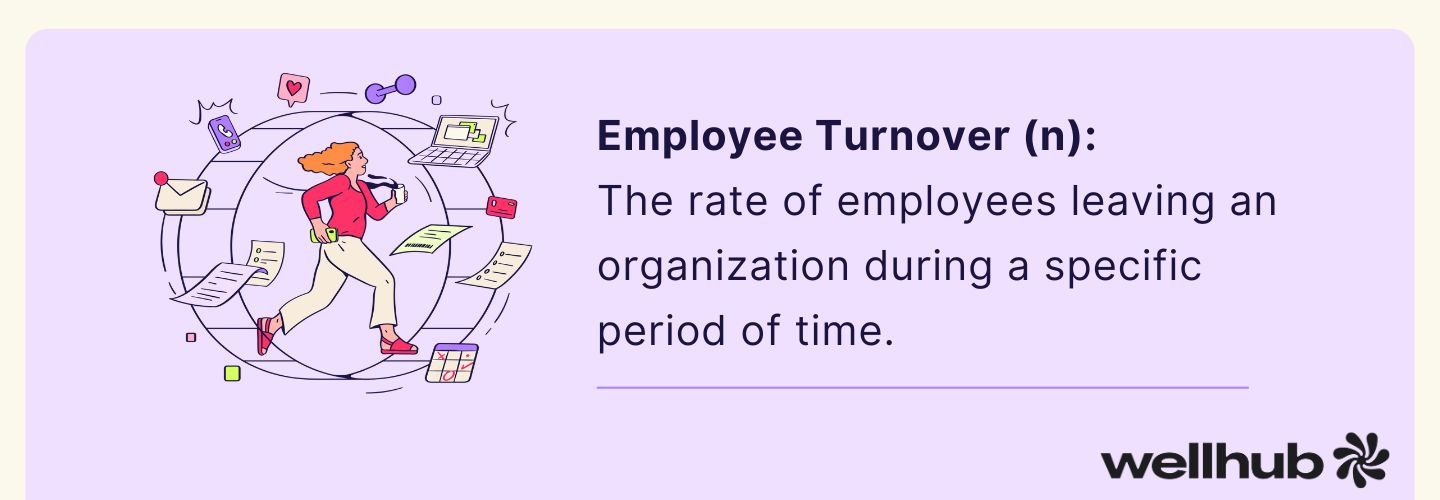
If your company’s turnover rate consistently exceeds the industry average, it's time to start investigating why. When analyzing turnover, HR leaders should distinguish between two categories:
- Voluntary turnover is when employees leave on their own, often due to dissatisfaction with culture, compensation, workload, or career growth opportunities.
- Involuntary turnover is when employees are dismissed due to performance issues, restructuring, or other organizational decisions.
Understanding the balance between voluntary and involuntary turnover gives HR leaders a clearer picture of why employees are leaving—and where to focus on improvement.
The Importance of Reducing Employee Turnover
Every employee departure drains resources through recruiting and training costs, slows productivity as teams adjust, and affects morale. Over time, high turnover can even weaken a company’s reputation in the talent market.
For HR leaders and executives, reducing turnover isn’t just a way to cut costs—it’s a strategic priority to control expenses, sustain productivity, strengthen culture, and build a trusted employer brand.
Lower Costs Related to Employee Turnover
Replacing a worker can cost a company anywhere from around half to two times the worker's annual salary, depending on their role, according to Gallup. Recruitment, training, and onboarding all require significant resources, and these costs repeat every time an employee leaves. The lower the turnover, the fewer recurring expenses you’ll have, making it easier to stabilize budgets.
Increased Productivity and Efficiency
New employees need time to become familiar with their duties, team members, company culture, and workflows. As such, productivity dips during this time. A high retention rate minimizes these slowdowns.
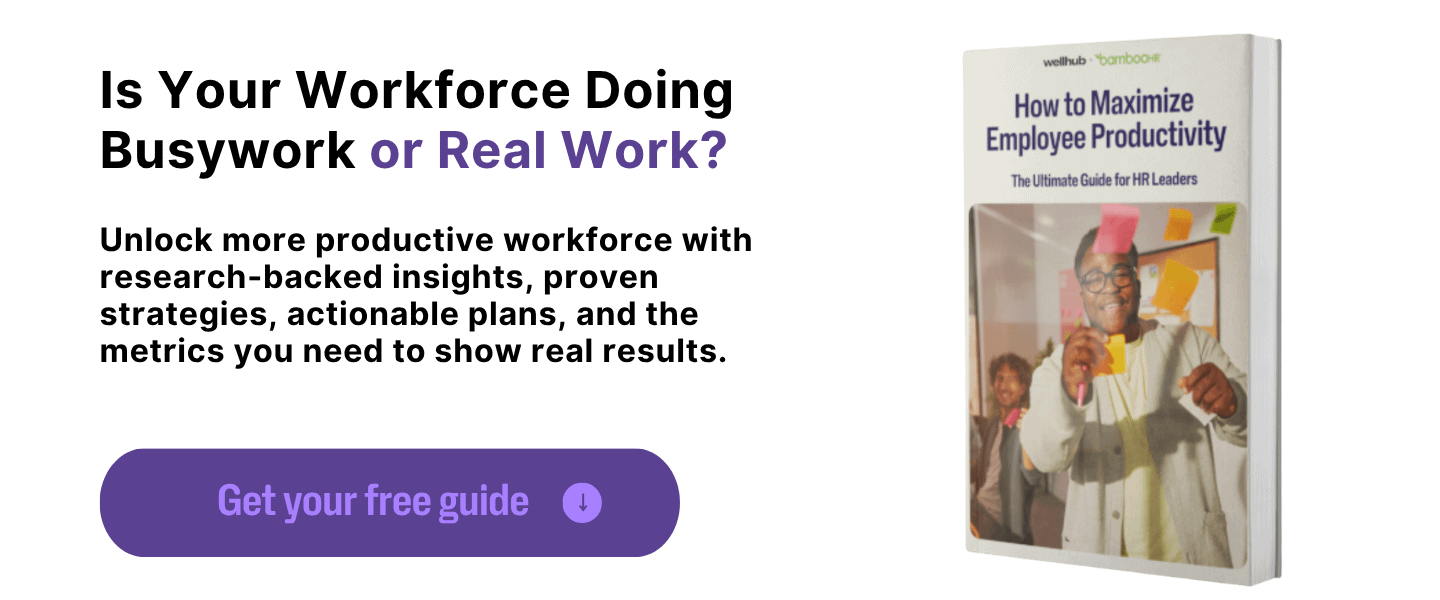
Improved Morale and Company Culture
Constant turnover can chip away at team morale. Every time someone leaves, work is pushed onto the remaining employees, leading to overtime, frustration, fatigue, and even resentment. When several employees leave in a short time, it can also raise doubts about the company’s future.
By contrast, lower turnover fosters a stable and engaged culture. With fewer disruptions, employees can focus on collaboration instead of constantly adjusting to change.
Enhanced Employer Brand and Reputation
Minimizing turnover also strengthens an organization’s brand. Word gets around. The higher your turnover, the less likely top candidates will apply, especially when they see the same roles repeatedly posted on platforms like Indeed or Glassdoor. On the other hand, strong retention signals stability and trust, making prospective employees and top talent more likely to apply.
How to Reduce Employee Turnover (Tips & Strategies)
Ready to take advantage of everything that comes with a low turnover rate? Here are eight actionable strategies you can start working on today.
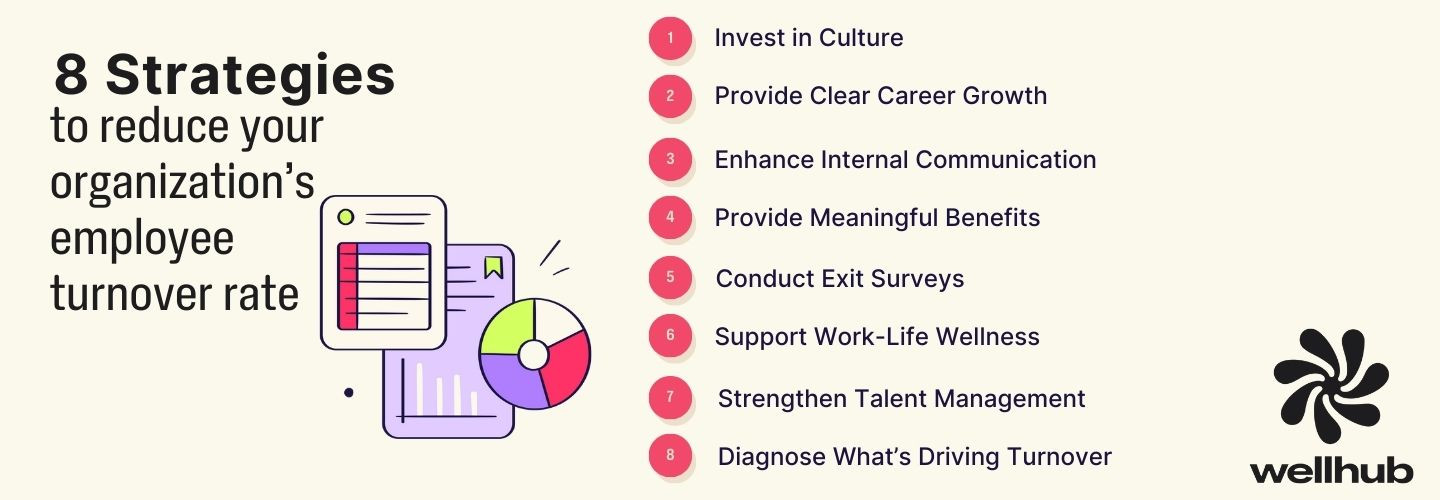
- Invest in Your Organizational Culture
A positive workplace culture is the foundation of retention. Employees who feel valued, respected, and connected are less likely to leave. In fact, well-recognized employees were 45% less likely to switch companies within two years, according to Gallup.
Here are some ways HR leaders can strengthen culture:
- Promoting transparent communication between leadership and staff. For example, leaders can hold quarterly “ask me anything” sessions where employees can openly raise questions about strategy, performance, or challenges.
- Recognizing and celebrating team achievements regularly. A simple, consistent program—such as spotlighting employees in monthly newsletters or giving gift cards for milestone projects—shows that the company values their employees and their contributions.
- Encouraging inclusion and belonging across all departments. Some ways to ensure equity throughout the company include cross-functional team-building events, employee resource groups, and regular promotion practice reviews.
- Providing channels for employees to share their opinions, such as “town halls” or surveys. For instance, companies could run quarterly pulse surveys and then share how leadership is acting on the feedback. This lets employees know their input matters.
- Building trust by ensuring leaders follow through on commitments. If leadership promises more career-growth opportunities, make sure they follow through.
- Offer Career Development and Growth Programs
Employees stay where they can grow.
Younger generations, in particular, are likely to leave a job if it doesn’t challenge them or align with their ambitions. Specifically, 83% of Gen Z consider themselves job hoppers, according to a ResumeLab survey of over 1,100 Gen Z U.S.-based workers. Unlike their older peers, they don’t view changing jobs as a lack of commitment. Rather, they believe in actively seeking new challenges and environments that match their career goals.
To match prospective employees’ preferences, HR leaders and executives should offer career development programs that demonstrate commitment to employees’ futures.
Ways to strengthen growth opportunities include:
- Establishing mentorship and coaching initiatives. By pairing early-career employees with senior leaders, the former can navigate challenges more easily, build networks, and envision a long-term future at the company. For instance, a marketing associate could meet monthly with a director who guides them on campaign strategy and career planning.
- Mapping transparent career ladders within each role. Employees often feel that the career ladder is opaque, so managers and HR leaders should clearly outline the specific skills or milestones required for promotion. A software engineer, for example, could see that leading a project team and completing a certification are the next steps toward a senior title.
- Offering professional training, upskilling, and certifications. Investing in employee growth—such as sponsoring cybersecurity certifications for IT staff or leadership workshops for managers—both improves company capabilities and reduces the urge to look elsewhere for development.
- Supporting cross-functional projects that broaden skills. Employees who work outside their silo gain fresh perspectives and avoid stagnation.
- Providing tuition reimbursement or learning stipends. Covering the cost of graduate programs, online courses, or professional conferences shows you care about your employees’ futures.
- Enhance Communication and Engagement
Strong communication and engagement form the backbone of retention strategies. Employees who feel informed and heard are more likely to be engaged, and engaged employees are far less likely to leave.
Here are some ways HR leaders can foster engagement:
- Hold regular one-on-one check-ins between managers and employees.
- Share company goals and progress with transparency.
- Encourage feedback through surveys and open forums.
- Recognize individual contributions during team meetings.
- Link employees’ daily work to the organization’s broader mission.
- Provide Meaningful Benefits
Fair compensation is important, but it’s not the only reason employees stay. You should also consider designing benefits for retention. This shows you care about your employees’ mental and physical wellbeing.
Examples of meaningful benefits include:
- Comprehensive health coverage, such as medical, dental, and vision insurance
- Paid time off (PTO) and holidays
- Retirement plans and financial wellness tools
- Elder care assistance
- Life and disability insurance
- Flexible work arrangements and remote options
- Comprehensive employee wellbeing programs
- Career development stipends
- Paid parental leave
- Pet insurance
- Equity or stock options
Don't forget that clarity matters just as much as coverage. Without a clear and accessible employee benefits guide, many employees won’t fully understand what they’re entitled to or how to access them. A well-designed guide removes confusion, improves benefit utilization, and reinforces the company’s investment in its people.
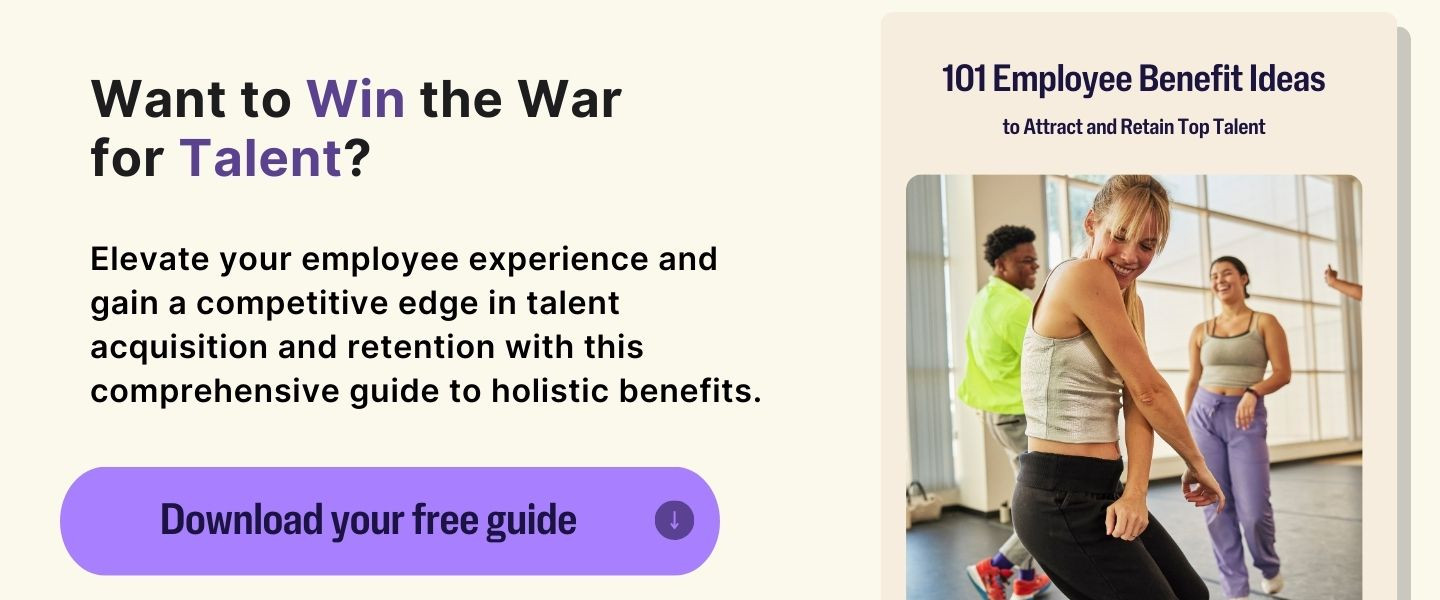
- Conduct Feedback and Exit Surveys
Feedback and exit surveys are also key to retention. Besides leaders giving performance reviews to employees, employees should also be able to provide feedback to leaders and management. That way, HR leaders and executives can identify areas for improvement in the organizational structure and culture.
By actually listening to employee feedback and implementing suggestions as needed, you demonstrate that you value their input and care about their experience.
Best practices for conducting feedback and exit surveys include:
- Running regular pulse surveys to gauge employee sentiment
- Creating anonymous feedback channels to encourage honesty
- Conducting structured exit interviews to identify why employees are leaving
- Acting on survey results and communicating the changes made
- Encourage a Healthy Work-Life Wellness
Employees today want more than just a paycheck—they want sustainable, healthy roles that support their overall wellness, both in and out of work. Poor balance—often the result of lack of flexibility, unrealistic workloads, and constant “always-on” expectations—can lead to burnout, a key driver of turnover.
To support work-life wellness and show employees you care about more than just results and key performance indicators (KPIs), HR leaders and executives should:
- Offer flexibility in schedules and locations
- Enforce realistic workload expectations
- Encourage use of PTO and vacations
- Provide resources for preventing burnout, such as wellbeing workshops and mindfulness tools
- Model balance at the leadership level to set healthy norms
- Improve Talent Acquisition and Recruitment
Retention starts before onboarding an employee. From the get-go, it's important to hire candidates whose values align with company culture. This increases the likelihood that the employee is satisfied with their job and reduces the potential for burnout and eventual exits.
Strategies for recruiting better fits include:
- Writing accurate, detailed job descriptions
- Using structured interviews to reduce bias
- Providing a positive candidate experience from first contact to onboarding
- Strengthening talent acquisition pipelines with diverse sourcing
- Building a thorough onboarding process that introduces new hires to culture and expectations
Not all turnover is the same. Find out which types matter most—and how to manage them strategically.
- Analyze What's Driving Your Turnover Rates
The more data you have, the better a strategy you can create for increasing retention. Besides knowing your turnover and retention rates, HR leaders should break this number down further by:
- Segmenting turnover data by department, role, or manager
- Comparing voluntary vs. involuntary exits
- Tracking tenure of employees who leave to spot patterns
- Benchmarking turnover rates against industry averages
- Using findings to inform employee benefit and retention programs
Turnover rate analysis isn’t a one-time task. When you do it multiple times a year—ideally quarterly—you’ll find it easier to identify root causes and ensure retention efforts are targeted and effective.
Strengthen Your Workforce With Employee Wellness
To reduce turnover and increase retention and trust, you need a holistic approach. Besides investing in your organizational culture and offering career development, you also need to enhance communication, provide meaningful benefits, conduct feedback surveys, encourage a healthy work-life balance, improve talent acquisition from day one, and analyze your turnover rates.
One of the best ways to address these strategies and reduce employee turnover is by implementing a comprehensive employee wellbeing program. Such programs provide employees with tools to support their energy, resilience, and engagement, such as mindfulness and physical activity resources.
Speak with a Wellhub wellbeing specialist to learn how tailored wellbeing solutions can support your retention goals and help you build a stronger, more stable, and less burned-out workforce.

Company healthcare costs drop by up to 35% with Wellhub*
See how we can help you reduce your healthcare spending.
[*] Based on proprietary research comparing healthcare costs of active Wellhub users to non-users.
Category
Share

The Wellhub Editorial Team empowers HR leaders to support worker wellbeing. Our original research, trend analyses, and helpful how-tos provide the tools they need to improve workforce wellness in today's fast-shifting professional landscape.
Subscribe
Our weekly newsletter is your source of education and inspiration to help you create a corporate wellness program that actually matters.
Subscribe
Our weekly newsletter is your source of education and inspiration to help you create a corporate wellness program that actually matters.
You May Also Like

Talent Management: Definition, Benefits, and Strategies | Wellhub
Discover talent management best practices to attract, retain, and develop top talent. Leverage these benefits and strategie to align with your business goals.

Employment At Will: What It Means for Employers | Wellhub
At-will employment offers termination flexibility for employers and employees. Explore strategies to mitigate risks and ensure fair practices in the workplace.

6 Essential Team Lead Responsibilities | Wellhub
Team leads take on many responsibilities to help their team be successful. Discover which responsibilities are the most critical for success.